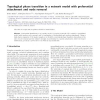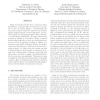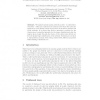183 search results - page 5 / 37 » The Degree Distribution of Random k-Trees |
107
click to vote
CORR
2012
Springer
13 years 8 months ago
2012
Springer
Preferential attachment is a popular model of growing networks. We consider a generalized model with random node removal, and a combination of preferential and random attachment. U...
103
Voted
ICNS
2009
IEEE
15 years 7 months ago
2009
IEEE
What is the impact of obstacles on the graphs of connections between stations in Mobile Ad hoc Networks? In order to answer, at least partially, this question, the first step is ...
BSL
2005
15 years 21 days ago
2005
A mass problem is a set of Turing oracles. If P and Q are mass problems, we say that P is weakly reducible to Q if every member of Q Turing computes a member of P. We say that P i...
SASO
2008
IEEE
15 years 7 months ago
2008
IEEE
Many real–world networks show a scale–free degree distribution, a structure that is known to be very stable in case of random failures. Unfortunately, the very same structure ...
105
Voted
IWOCA
2009
Springer
15 years 7 months ago
2009
Springer
Abstract. We analyze special random network models – so-called thickened trees – which are constructed by random trees where the nodes are replaced by local clusters. These obj...



